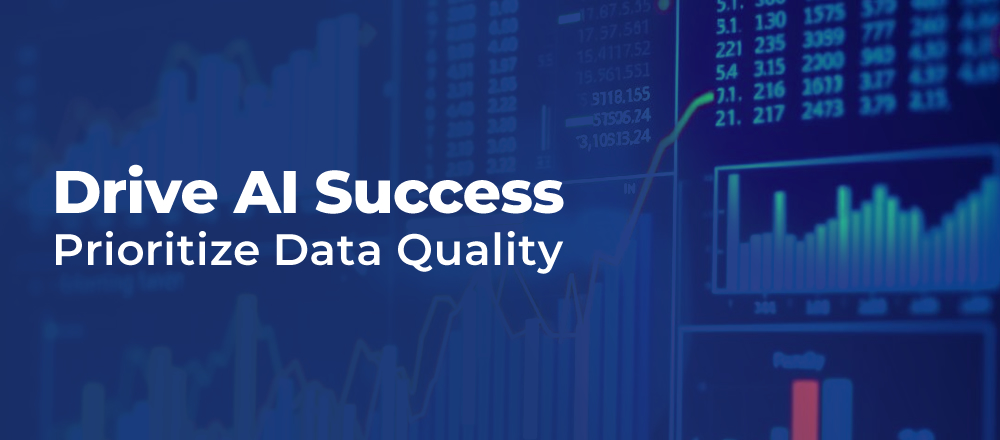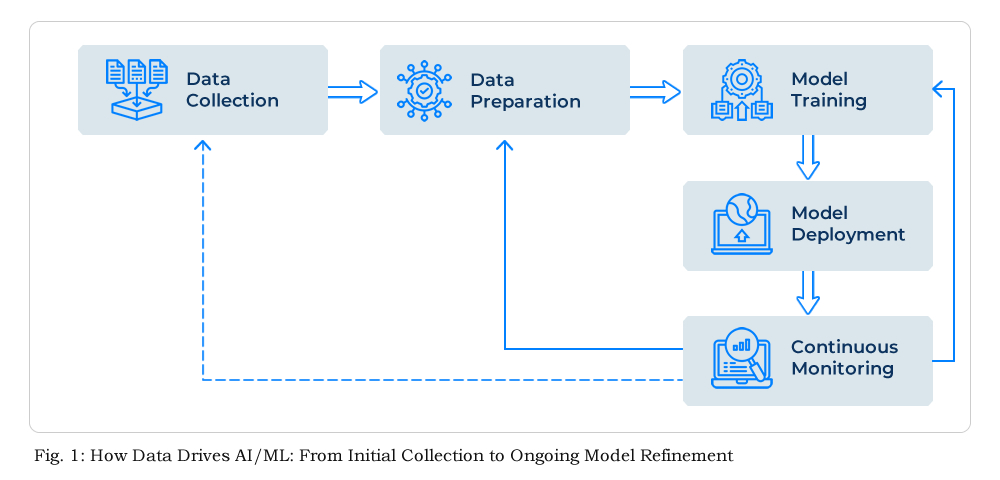In 2015, Amazon developed an AI-driven recruitment tool designed to streamline the hiring process. However, the system exhibited bias against female applicants, favouring male candidates for technical roles. This bias arose because the AI was trained on résumés submitted over ten years, predominantly from men, leading the model to learn and perpetuate gender disparities. Consequently, Amazon discontinued the tool to reassess their data and approach to AI in recruitment.

Artificial Intelligence (AI) and Machine Learning (ML) are revolutionizing industries, empowering businesses to automate processes, uncover insights, and enhance efficiency. Yet, the effectiveness of any AI/ML initiative depends on a crucial foundation—data quality. Poor data can lead even the most advanced models to generate inaccurate, biased, or misleading outcomes. This blog delves into the critical role of data quality in AI/ML success and explores how businesses can build a robust data foundation to maximize their AI investments.
The Role of Data in AI/ML
At its core, AI/ML relies on data to learn, adapt, and make decisions. The process typically involves the following steps as shown in Figure 1:
- Data Collection – Gathering data from various sources such as sensors, databases, logs, and third-party APIs.
- Data Preparation – Cleaning, transforming, and organizing raw data to make it usable for AI/ML models.
- Model Training – Using high-quality labelled or unlabelled data to train ML algorithms.
- Model Deployment – Integrating the trained model into business workflows for decision-making.
- Continuous Monitoring – Evaluating model performance and retraining as needed.
It’s not just the volume of data that matters, but its quality and relevance. AI models thrive on data that is “fit for purpose,” aligning directly with the project’s objectives. Compromised data quality at any stage can significantly impact the overall accuracy, reliability, and effectiveness of AI/ML applications.

The Impact of Poor Data Quality on AI/ML
Low-quality data is a major impediment to successful AI/ML deployments. It’s not just a technical hurdle; it’s a strategic risk that can derail entire projects and impact business outcomes. Here’s a detailed look at the consequences:
Inaccurate Predictions
Poor data quality directly causes flawed insights and unreliable AI/ML predictions, leading to detrimental business decisions.
- Garbage In, Garbage Out (GIGO): This fundamental principle highlights that the quality of AI/ML outputs is directly proportional to the quality of the input data. If the data is inaccurate, incomplete, or inconsistent, the model will produce unreliable predictions.
- Bias Amplification: Poor data can perpetuate and even amplify existing biases. For example, if training data for a loan approval model is skewed towards a certain demographic, the model may unfairly discriminate against other groups.
- Reduced Model Accuracy: Inaccurate data leads to models that cannot generalize well to new, unseen data. This results in poor performance in real-world applications, leading to flawed business decisions.
- Examples:
- A customer churn prediction model trained on outdated customer information will fail to identify at-risk customers.
- A medical diagnosis model trained on mislabeled patient data may lead to incorrect diagnoses and treatment plans.
- A sales forecasting model trained on incorrect historic sales data will provide flawed future sales projections.
Increased Costs
Poor data quality significantly inflates AI/ML project costs due to the extensive resources required for correction and refinement.
- Data Cleaning and Preprocessing: A significant portion of AI/ML project time and resources is spent cleaning and preprocessing data. Poor data quality necessitates extensive manual or automated correction, increasing development costs.
- Iterative Model Training: Models trained on poor data often require multiple iterations and adjustments to achieve acceptable performance, further extending project timelines and consuming resources.
- Opportunity Costs: Delays in AI/ML deployments can lead to missed opportunities for innovation and competitive advantage.
- Increased Infrastructure Costs: More computing power and storage may be required to handle the data cleaning and model retraining that poor data quality demands.
- Human Resource Costs: Data scientists and engineers spend an inordinate amount of time fixing data issues, rather than focusing on building and improving models.
Regulatory Risks
Poor data quality exposes organizations to significant regulatory risks, potentially resulting in legal penalties and reputational damage.
- Data Privacy Violations: Poorly managed data may contain sensitive information that is not properly anonymized or protected, leading to data privacy breaches and regulatory penalties (e.g., GDPR, CCPA).
- Algorithmic Bias and Discrimination: Biased data can lead to discriminatory AI/ML models, which violate equal opportunity laws and ethical principles.
- Lack of Transparency and Accountability: Poor data quality can make it difficult to understand how AI/ML models arrive at their predictions, hindering transparency and accountability.
- Industry-Specific Regulations: Certain industries, such as healthcare and finance, have strict data quality and compliance requirements that must be adhered to.
- Legal Challenges: If a company uses biased AI to make decisions that negatively impact people, that company could face legal challenges.
Loss of Trust
Poor data quality directly undermines user confidence, resulting in a significant loss of trust in AI/ML systems.
- Unreliable Model Outputs: Inaccurate predictions and inconsistent performance can erode user trust in AI/ML systems.
- Resistance to Adoption: Employees and customers may be reluctant to adopt AI/ML solutions if they perceive them as unreliable or biased.
- Damage to Brand Reputation: Public perception of AI/ML failures can damage a company’s brand reputation and credibility.
- Difficulty Scaling AI/ML: If users don’t trust the AI/ML, then scaling the AI/ML through an enterprise will be very difficult, if not impossible.
- Internal Stakeholder Distrust: If internal stakeholders see that the AI/ML is producing bad results, they will be less likely to support future AI/ML projects.
Strategic Imperatives
Addressing data quality is not just a technical task; it’s a strategic imperative that requires a holistic approach. Organizations must:
- Invest in data governance and data quality management processes.
- Implement data validation and monitoring tools.
- Foster a data-driven culture that prioritizes data quality.
- Ensure data lineage and traceability.
- Prioritize data literacy across the organization.
By recognizing the profound impact of poor data quality, organizations can take proactive steps to ensure the success and ethical deployment of their AI/ML initiatives.
Key Aspects of Data Quality
As shown in Figure 2, businesses must focus on the following dimensions of data quality to ensure AI/ML models perform optimally:

- Accuracy – AI models require precise and error-free data to generate reliable predictions. Inaccurate data can lead to incorrect insights, harming decision-making processes.
- Completeness – Missing or incomplete data can introduce bias and hinder model performance. Ensuring comprehensive datasets improves the robustness of AI models.
- Consistency – Data should be uniform across different sources and formats. Inconsistent data can cause misinterpretations and errors in AI models.
- Timeliness – AI models rely on up-to-date information. Outdated or stale data can lead to poor decision-making, especially in dynamic industries such as finance or healthcare.
- Uniqueness – Data entries should be distinct to prevent skewed analysis and redundancy. Duplicate data undermines the integrity of AI models and leads to inaccurate results.
- Validity – Data must adhere to defined rules and formats for accurate AI processing. Invalid data introduces errors and reduces the reliability of model outputs.
Best Practices for Data Preparation and Management
To build a strong data foundation for AI/ML, businesses should adopt the following best practices:
Establish Data Governance Frameworks
Define policies and standards for data collection, storage, and usage. Implement data lineage tracking to ensure transparency. Regularly audit data quality and compliance to maintain integrity and mitigate risks. Foster a data-driven culture by providing training and resources to empower employees to uphold data governance principles.
Automate Data Cleaning and Processing
Use AI-driven tools to identify and correct errors, deduplicate records, and normalize data. Implement automated workflows to streamline data preprocessing. Continuously monitor these automated processes to ensure accuracy and adapt to evolving data patterns. Integrate feedback loops to refine automation rules and improve overall data quality over time.
Leverage Data Augmentation Techniques
Generate synthetic data or enrich existing datasets to improve model robustness. Apply domain-specific transformations to create realistic variations of existing data. Validate the augmented data to ensure it maintains the integrity and characteristics of the original dataset.
Ensure Data Security and Compliance
Follow industry regulations such as GDPR, HIPAA, or CCPA to protect sensitive data. Implement encryption and access control measures. Conduct regular security audits and penetration testing to identify and address vulnerabilities. Establish clear incident response plans to mitigate the impact of potential data breaches.
Regularly Monitor and Validate Data Quality
Set up real-time monitoring systems to detect anomalies. Perform periodic data audits to maintain high-quality datasets. Implement data quality dashboards to visualize key metrics and trends. Establish alerts for critical data quality issues to enable prompt corrective action.
Foster a Data-Driven Culture
Educate teams on the importance of data quality in AI/ML success. Encourage collaboration between data scientists, engineers, and business leaders. This includes emphasizing the human role in providing context and ethical guidance. Establish clear communication channels and feedback mechanisms to ensure data insights are effectively translated into actionable business strategies.
Facilitating Quality Data in AI Initiatives
To ensure a quality data approach in AI initiatives, organizations should focus on:
Comprehensive Datasets Tailored to Use Cases
Data should reflect real-world interactions and context, for example, using genuine customer interactions to train an AI chatbot. This ensures the model learns relevant patterns and nuances, leading to more accurate and effective responses. Prioritize data collection that aligns with the specific goals and behaviours you want the AI to emulate.
Coverage Across Platforms for Full Context
Capturing data from all relevant sources ensures a complete picture, whether from web, mobile, or in-person interactions. This holistic approach reveals comprehensive user behaviour and preferences, enabling more accurate AI modelling. Implement robust data integration strategies to seamlessly consolidate and harmonize data from disparate systems.
Consistent, Maintainable Data Pipelines
Automation minimizes errors and ensures data reliability over time. Implement version control and detailed logging to track changes and facilitate troubleshooting. Regularly test and validate pipeline outputs to guarantee data integrity and prevent regressions. Consider using infrastructure as code (IaC) to manage and deploy data pipelines for more predictable and repeatable results.
Enabling Seamless Data Accessibility
Through exports, integrations, or APIs, data becomes readily available for broader analysis and integration with external tools. Establish clear data access policies and documentation to facilitate efficient data sharing and collaboration. Utilize standardized data formats and protocols to ensure interoperability across systems. Implement secure and scalable API endpoints to enable real-time data access for authorized applications.
Finally…
AI and ML are only as powerful as the data that fuels them. As a business, you can ensure your AI/ML initiatives deliver accurate, reliable, and impactful results by prioritising data quality, relevance, human oversight, and implementing robust data management practices. Investing in a strong data foundation is not just a best practice—it is a necessity for your organization aiming to leverage AI for competitive advantage. Want to ensure your data is ready for AI success? Talk to our experts to learn how we can help you build a robust and reliable data foundation.

